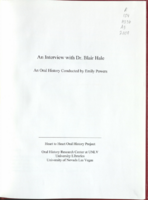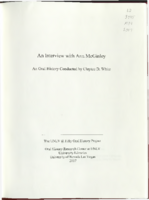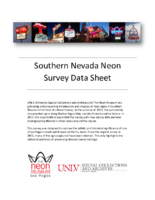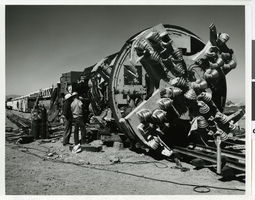Search the Special Collections and Archives Portal
Search Results

Transcript of interview with Blair Hale, by Emily Powers, June 16, 2006
Date
2008-06-16
Archival Collection
Description
Dr. Blair Hale has been practicing dentistry in Las Vegas for over thirty years. He was born in Idaho in 1949, the third of four children born to Zendal McKay and Lenny Raymond Hale. His education includes semesters at BYU, El Camino City College, and a dental degree from Washington University. Dr. Hale recounts his experiences as an undergraduate at Washington University in Missouri, living in a dorm situation and signing for government loans. He also examines his early days in Las Vegas and the ease with which he obtained bank loans to start his business back in 1976. At that time there were relatively few dentists practicing in Las Vegas, and when he was the dentist society president in 1985, he knew most dentists by name. Blair explains his work with the Academy of LDS Dentists, which sends groups of dentists to Guatemala, Peru, Honduras, and the Dominican Republic to run week-long free clinics. The clinics not only treat the dental problems of the populace, but also serve as instructional seminars for local practitioners. In addition to running a practice and doing charitable work outside the country, Dr. Hale also teaches at UNLV's dental clinic one day per week. He describes the changes in technology, technique, and materials over the years, and the quality education future dentists receive at UNLV. He also delineates the differences dental work can make in a patient's life, not just aesthetically but emotionally and physically as well. Dr. Hale comments on the dynamics behind the large influx of dentists in the 90s, the future of health care in Las Vegas, and the impact of third-party carriers in the dental profession. He believes that dentistry is a wonderful profession and that students can receive an excellent education at any good dental school in the United States. His sons are contemplating following him into this field.
Text

Interview with William Gus Flangas, November 12, 2004
Date
2004-11-12
Archival Collection
Description
Narrator affiliation: Operations Division Manager & Vice President, REECo
Text

Interview with Raymond Chester Harbert, July 14, 2005
Date
2005-07-14
Archival Collection
Description
Narrator affiliation: Resident Engineer, Holmes and Narver; Program Manager, Plowshare
Text

Interview with Lawrence Frerric Krenzien, September 8, 2005
Date
2005-09-08
Archival Collection
Description
Narrator affiliation: Resident Test Director, Los Alamos National Laboratory
Text

University of Nevada, Las Vegas (UNLV) 6th commencement program
Date
1969-06-05
Archival Collection
Description
Commencement program from University of Nevada, Las Vegas Commencement Programs and Graduation Lists (UA-00115).
Text
Audio clip of an interview with Kenneth Fong by Lois goodall on February 22, 2014
Date
2014-02-22
Archival Collection
Description
Kenneth Fong reflects on growing up in Las Vegas and being the son of two successful and philanthropic community members, Wing and Lilly Fong. When Ken was born the family live in a modest home on 20th and Stewart. It was a close-knit neighborhood and era, kids played tag and roamed freely. When he entered third-grade, his parents moved their family to a newer subdivision near Rancho and West Charleston Avenue: the Scotch 80s. Their new custom home on Silver Avenue reflected Asian architecture and the family’s Chinese cultural heritage; it also included a pool and a small basketball court. Memories of the neighborhoods are distinct. He learned to be comfortable with his sister and he being the only Asian Americans in school at the time. He kept busy with community volunteering at Sunrise Hospital and tutoring younger children on the Westside among other high school activities. Ken speaks lovingly of his parents and their achievements, family outings to local venues such as Mount Charleston and Red Rock and to California, where they bought Chinese baked goods. His mother, Lilly was born into a large Chinese American family of ten children, each of whom achieved a college education. After her marriage to Wing, she moved to Las Vegas with plans to work as a teacher. Ken retells the story of her encounter with discrimination and overcoming that, and her trajectory to be the first Asian American elected the Nevada Board of Regents. His orphaned father, Wing, immigrated to the United Sates in 1939 to live with uncles. They worked as cooks in Las Vegas and established the first Las Vegas Chinese restaurant, Silver Café. Wing was merely thirteen years old and spoke no English. These were not to be obstacles. He would go on to graduate from Las Vegas High School, earn a college degree in business, have a successful career in commercial real estate and banking, building the notable Fong’s Garden. Ken calls his father his most influential mentor. Today Ken is also a successful in real estate management, active at Grace Presbyterian Church, involved in Rotary Club, and a proud father of two daughters.
Sound

Transcript of interview with Ann McGinley by Claytee D. White, August 01, 2006
Date
2006-08-01
Archival Collection
Description
Ann McGinley grew up in Allentown, Pennsylvania, the third child in a family of four. Her mother was a homemaker and her father was a lawyer. It was because of her father that she became interested in civil rights. Ann attended college and majored in Spanish. She earned a master’s degree and taught in Spain for five years. Her brother and his wife were lawyers and she decided to go back to law school at the University of Pennsylvania. Ann did a two year clerkship for a federal judge, doing research and drafting opinions. She met her husband-to-be during this time and they mover to Minneapolis. Ann did commercial litigation and worked on a class action suit against the school system on behalf of the American Indian population. Her husband wanted to teach and was hired by Brooklyn Law School. Their first child was on the way and Ann studied for the bar in New Jersey. She then worked for a small firm in Labor and Employment Discrimination. A teaching job at Brooklyn Law School opened up and she worked part-time there for four or five years, meanwhile giving birth to two more children. It then seemed like the right time to make a career move, so Ann and her husband applied and were hired at Florida State in Tallahassee. After watching others being denied tenure and having experienced that denial themselves, they were ready to move on. A phone call from Carl Tobias inviting them to UNLV was followed up with interviews, and the McGinley’s made the move to Las Vegas. Ann and her family settled in Green Valley in 1999 during Carol Harter’s administration. Ann drafted the plan for a clinical program, which uses real clients to help train law students, and has helped build other programs for the law school. Ann now teaches employment law, employment discrimination, disabilities discrimination law, torts, and occasionally civil procedure. Her vision for the future of the law school is for it to continue with its social mission, and perhaps for a satellite campus to open at UNR. She is confident that the UNLV law school will continue to be a place where women can thrive.
Text

The Dunes Hotel tower under construction: photographic film
Date
1960 (year approximate) to 1986 (year approximate)
Archival Collection
Description
A view of the Dunes Hotel tower under construction. The famous sultan statue is visible in the foreground. The marquee is visible in the background advertising "Now in the Persian Room Vive Les Girls French Stage Spectacular 8:30 pm, 11:30 pm, 1:15 am" and "Persian Room All new direct from Paris Vive Les Girls! Produced by Danny Costello Star of the Ed Sullivan Show". The Dunes, which was themed after the Arabian Nights stories, opened on May 23, 1955 with 200 hotel rooms, located in several two-story buildings. From the time of its opening, the Dunes was known for the 35 foot tall fiberglass sultan statue that stood above its main entrance. In 1961, a 24-story, 250-room hotel tower, known as Diamond of the Dunes, was added to the northern part of the property, bringing the total number of rooms to 450. At the top of the tower was the Top O' the Strip restaurant and lounge. The tower was the tallest building in the state at the time. In 1979, the South Tower was added, expanding the hotel to 1300 rooms. A second casino in a separate, round building on the site opened in 1983 under the name Oasis Casino at The Dunes. In 1985, the sultan statue was moved to the golf course during renovations, and later caught fire, reportedly due to an electrical short. On November 17, 1992, the Dunes was sold to Wynn's company, Mirage Resorts, Inc., for $75 million. On January 26, 1993, the Dunes closed its doors for good. Steve Wynn bought the Dunes and started the redevelopment trend with the demolition of the 32-year-old North Tower. On October 27, 1993, the Dunes was demolished in a grand ceremony that involved major fireworks displays and the use of several "cannon blasts" from the English ship 'HMS Britannia' of Treasure Island Hotel and Casino. The 15-year-old South Tower was demolished 9 months later in July 1994, with no fanfare and minimal media attention. The Bellagio now stands in its place. The property is located at 3600 Las Vegas Boulevard South, Las Vegas, NV 89109.
Image

Arizona Charlie's Hotel and Casino Neon Survey document, August 18, 2017
Date
2017-08-18
Archival Collection
Description
Information about the Arizona Charlie's Hotel and Casino sign that sits at 4575 Boulder Hwy.
Site address: 4575 Boulder Hwy
Sign owner: American Casino and Entertainment Properties LLC
Sign details: Currently Arizona Charlie's Boulder is owned by the Parent company American Casino and Entertainment Properties LLC. The original Arizona Charlie's on Decatur was first opened around the 1980's owned by Ernest Becker III and his three sons. These locations were named for Becker's uncle Charlie Meadows. The Becker family has had a long history of development and real estate. Arizona Charlie's Boulder opened in 2001.
Sign condition: 5 - looks new
Sign form: Super Pylon
Sign-specific description: Octagonal design. Effigy of a cowboy at its center in an oval plastic backlit sign. There is the words "Arizona Charlie's Boulder" in channeled neon letters. Underneath is a Reader Board with a LED video screen.
Sign - type of display: Neon, Incandescent, Plasma T.V. screen and reader board
Sign - media: Steel and plastic
Sign - non-neon treatments: LED plasma screen and Incandescents
Sign animation: Flasher for incandescent bulbs
Sign environment: A residential area surrounds the property, and adjacent to the main property is their own RV park.
Sign manufacturer: Possibly YESCO
Sign - date of installation: c. 2007
Sign - thematic influences: The Red and yellow/gold color scheme adds an old west and cowboy theme to the sign. The old West theme was very prominent in Las Vegas in the 1940's.
Survey - research locations: Assessor's Page, Arizona Charlie's Website
Survey - research notes: http://www.arizonacharliesboulder.com/?gclid=Cj0KEQjw9uHOBRDtz6CKke3z6ecBEiQAu0Jr3mlOR65dHh6OypoEF3LcYOCTWpwRltGP9Kh6YWjwBKgaApoi8P8HAQ
Surveyor: Wyatt Currie-Diamond
Survey - date completed: 2017-08-18
Sign keywords: Pylon; Neon; Incandescent; Steel; Plastic; Flashing; Reader board; Video screen
Site address: 4575 Boulder Hwy
Sign owner: American Casino and Entertainment Properties LLC
Sign details: Currently Arizona Charlie's Boulder is owned by the Parent company American Casino and Entertainment Properties LLC. The original Arizona Charlie's on Decatur was first opened around the 1980's owned by Ernest Becker III and his three sons. These locations were named for Becker's uncle Charlie Meadows. The Becker family has had a long history of development and real estate. Arizona Charlie's Boulder opened in 2001.
Sign condition: 5 - looks new
Sign form: Super Pylon
Sign-specific description: Octagonal design. Effigy of a cowboy at its center in an oval plastic backlit sign. There is the words "Arizona Charlie's Boulder" in channeled neon letters. Underneath is a Reader Board with a LED video screen.
Sign - type of display: Neon, Incandescent, Plasma T.V. screen and reader board
Sign - media: Steel and plastic
Sign - non-neon treatments: LED plasma screen and Incandescents
Sign animation: Flasher for incandescent bulbs
Sign environment: A residential area surrounds the property, and adjacent to the main property is their own RV park.
Sign manufacturer: Possibly YESCO
Sign - date of installation: c. 2007
Sign - thematic influences: The Red and yellow/gold color scheme adds an old west and cowboy theme to the sign. The old West theme was very prominent in Las Vegas in the 1940's.
Survey - research locations: Assessor's Page, Arizona Charlie's Website
Survey - research notes: http://www.arizonacharliesboulder.com/?gclid=Cj0KEQjw9uHOBRDtz6CKke3z6ecBEiQAu0Jr3mlOR65dHh6OypoEF3LcYOCTWpwRltGP9Kh6YWjwBKgaApoi8P8HAQ
Surveyor: Wyatt Currie-Diamond
Survey - date completed: 2017-08-18
Sign keywords: Pylon; Neon; Incandescent; Steel; Plastic; Flashing; Reader board; Video screen
Text

Photograph of the Jarva Tunnel Borer used on the Las Vegas River Mountain Project, Las Vegas, Nevada, circa 1968-1971
Date
1968 to 1971
Archival Collection
Description
Two unidentified men are examining the side view of the Jarva Tunnel Borer's cutter head. The first stage of construction was completed between 1968-1971, and is comprised of a main aqueduct, a 3.78 mile tunnel through the River Mountains, eight pumping plants, and 31.4 miles of pipeline. This stage has a peaking capacity of 26.7 million cubic feet of potable water per day. The second stage enlarged the first stage system by expanding some of the existing facilities. New features included five pumping plants, the second barrel to the main aqueduct, and about 30 miles of pipeline and laterals with surge tanks, regulating tanks, and other delivery facilities. In conjunction with this stage, the State of Nevada enlarged and modified the Alfred Merritt Smith water treatment facilities to accommodate additional water supplies. The River Mountains Tunnel was constructed to full capacity in the first stage, and the Saddle Island intake facilities were oversized to accommodate both stages. The aqueduct system has a peaking capability of 53.4 million cubic feet of water per day. The River Mountains Tunnel was constructed during the first stage to accommodate second stage expansion. It is 3.78 miles long and was excavated through the River Mountains, which lie between Las Vegas Valley and Lake Mead. The concrete-lined tunnel has an inside diameter of 121.5 inches, and a maximum capacity of 608 cfs. The SNWA also constructed a larger tunnel, parallel to the River Mountains Tunnel for further expansion. The River Mountains Tunnel is used to convey raw water from Lake Mead to the River Mountains Water Treatment Facility that SNWA constructed near Henderson, NV. The River Mountains Facility, which began delivering treated water in October 2002, treats up to 300 million gallons of water per day, and was designed so it can expand to meet Southern Nevada's needs. In the future, the River Mountains facility will be able to treat up to 600 million gallons of water a day. This facility provides additional reliability and capacity to Southern Nevada's municipal water treatment and distribution capabilities.
Image
Pagination
Refine my results
Content Type
Creator or Contributor
Subject
Archival Collection
Digital Project
Resource Type
Year
Material Type
Place
Language
Records Classification
